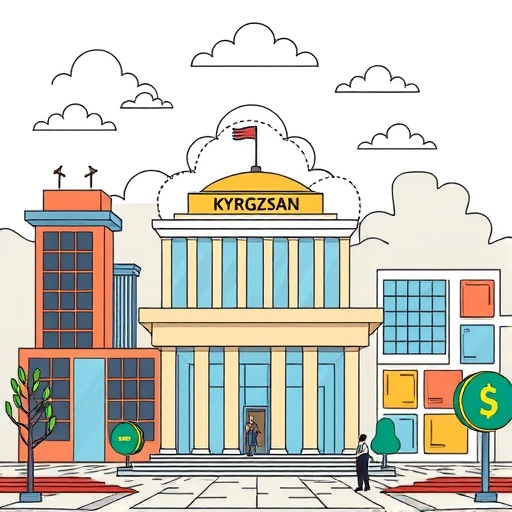Welcome to our in-depth exploration of the Kyrgyzstani Som (KGS). If you’re an investor, a trader new to technical analysis, or simply curious about the dynamics of developing economies and their currencies, you’ve come to the right place. Together, we’ll unpack the recent significant developments surrounding the KGS, from the robust health of its banking sector and ambitious plans for a digital currency to its debut in international bond markets. Understanding these layers is crucial for anyone looking to navigate the complexities of emerging market currencies.
The Kyrgyzstani Som (KGS) has been influenced by several key factors:
- Growth in the banking sector showing increased profitability and asset size.
- Introduction of a digital som to modernize the financial system.
- Significant milestones such as the issuance of KGS-denominated bonds by international entities.
To provide a clearer understanding of the banking sector’s performance, the following table summarizes key financial indicators:
| Indicator | Value (2025) |
|---|---|
| Net Profit of Banks | KGS 8.8 billion |
| Total Assets | KGS 930.1 billion |
| Loan Portfolio | KGS 393.8 billion |
| Client Deposits | KGS 687.9 billion |
Let’s begin by looking at the bedrock of any financial system: the banking sector. In Kyrgyzstan, the commercial banking system has demonstrated remarkable strength and growth recently. As of mid-2025, the numbers paint a very positive picture. We’ve seen a significant surge in profitability, with the net profit of Kyrgyz banks collectively exceeding KGS 8.8 billion since the start of 2025. This isn’t just a fleeting success; it reflects underlying improvements in operations, lending, and risk management.
Beyond profitability, the sector’s overall size and activity have expanded considerably. Total assets across the 21 commercial banks (including five offering Islamic finance principles) have increased impressively by 14% year-to-date, reaching KGS 930.1 billion from KGS 815.7 billion at the end of 2024. This asset growth is mirrored in the core business of banking – lending and deposits.

The loan portfolio, representing the lifeblood of economic activity by financing businesses and individuals, grew by a substantial 15.6%, reaching KGS 393.8 billion. Simultaneously, the client deposit base, indicating public confidence and savings accumulation within the banking system, saw an equally strong increase of 16.1%, rising to KGS 687.9 billion. These figures underscore a vibrant and expanding financial landscape within Kyrgyzstan.
One particularly noteworthy trend within the Kyrgyz banking sector is the noticeable decrease in dollarisation. Dollarisation refers to the extent to which a foreign currency, typically the US Dollar, is used within a country’s economy alongside or instead of the national currency. High dollarisation can expose an economy to external shocks and limit the effectiveness of domestic monetary policy.
The data from Kyrgyzstan shows a positive shift. The dollarisation of loans decreased to 19%, representing a 1.1% drop year-to-date. This means a larger proportion of loans are now denominated in KGS, reducing currency risk for borrowers whose income is in the national currency. Similarly, the share of foreign currency deposits also decreased by 5.1%. This suggests that depositors are increasingly comfortable holding their savings in Kyrgyzstani Som, reflecting growing confidence in the stability and future value of the national currency.
What drives de-dollarisation? Often, it’s a combination of factors: stable macroeconomic conditions, effective monetary policy by the National Bank, and potentially regulations or incentives encouraging the use of the local currency. This trend towards de-dollarisation is generally viewed positively by economists as it enhances financial stability and strengthens the National Bank’s control over the economy.
Perhaps one of the most forward-looking developments for the Kyrgyzstani Som is the progress being made towards a digital version. We are living in an era where central banks globally are exploring or actively developing Central Bank Digital Currencies (CBDCs). Kyrgyzstan is positioning itself among these innovators.

A significant milestone was reached with President Sadyr Japarov signing a law that establishes the legal framework for a digital som pilot project. This is a crucial step, as it officially recognizes the concept of a digital form of the national currency and provides the necessary legal basis for its development and potential issuance. Think of it like laying the foundation and getting the building permits before you start constructing a new, advanced financial system.
What exactly is a digital som in this context? The law defines it as the national currency in digital form. It is intended to complement, not necessarily replace, physical cash and traditional bank deposits. The goal is often to improve payment systems, enhance financial inclusion, and potentially provide new tools for monetary policy.
The newly signed law isn’t just symbolic; it amends the constitutional law on the National Bank of Kyrgyzstan, explicitly granting it the necessary powers to manage this new form of money. The law gives the National Bank exclusive right to issue the digital som. This exclusivity is vital – it ensures that the digital som, like physical cash, remains a liability of the central bank, maintaining trust and stability.
Furthermore, the National Bank is empowered to set the circulation rules for the digital som and manage its underlying platform. This means they will determine how transactions are processed, who can hold and use the digital som (e.g., individuals, businesses, banks), and the technical standards of the system. This centralized control is a key characteristic distinguishing a CBDC from decentralized cryptocurrencies.
While the digital som is currently in a pilot phase, the amendments provide it with legal status. Crucially, if and when it is officially issued for public use, the law specifies that it will also possess legal tender status. This means it would be legally recognized as a valid means of payment for debts and transactions throughout Kyrgyzstan, just like physical KGS banknotes and coins.
What’s the timeline for this exciting development? Kyrgyzstan plans to test the digital som in 2025. This pilot project will likely involve controlled environments or specific groups to assess the technology, user experience, and economic implications. Based on the outcomes of this pilot, a final decision on the full issuance of the digital som is expected to be made in 2026. This phased approach allows the National Bank to carefully evaluate the pros and cons before committing to a nationwide rollout.
Moving from domestic financial architecture to international markets, the Kyrgyzstani Som recently achieved a significant milestone: the issuance of its first bond denominated in the national currency by a major international financial institution. On November 7, 2024, the Asian Development Bank (ADB) successfully issued a bond worth KGS 427.5 million, which is approximately equivalent to $5 million at the time of issuance.

Why is this a big deal? It’s the first time the ADB, a multilateral development bank focused on promoting social and economic development in Asia and the Pacific, has issued a bond in Kyrgyz som. This action signals international confidence in the stability and usability of the KGS. For investors, it offers exposure to KGS-denominated assets, potentially providing diversification benefits.
Let’s look at the specifics of this bond. It’s a 3-year issue, meaning the principal amount will be repaid after three years. It carries a coupon rate of 10.5%. The bond was settled in US dollars, which is common for cross-border transactions even when the principal and coupon payments are calculated in a local currency. Standard Chartered Bank acted as the arranger, and the bond was fully subscribed by Record Currency Management, a specialist currency overlay and emerging market debt manager.
The ADB’s decision to issue a KGS bond is highly strategic and aligns with its broader mission. One primary purpose is to mitigate currency risk for an ADB-supported project in Kyrgyzstan. When development projects are funded in foreign currency (like USD) but generate revenue in the local currency (KGS), fluctuations in the exchange rate can pose significant financial risks. By borrowing in KGS, the ADB can match the currency of its funding with the currency of the project’s cash flows, effectively hedging this risk.
What project is this bond supporting? It’s a project aimed at supporting Micro and Small Enterprises (MSEs) in Kyrgyzstan. MSEs are crucial for job creation, innovation, and poverty reduction in developing economies. By providing financing in local currency, the ADB makes it easier for these small businesses to access funding without taking on foreign exchange risk themselves.
Furthermore, the project has a specific focus on gender equality and inclusive growth, channeling at least 40% of the funds to women-led/owned MSEs via Kompanion Bank, a local microfinance institution. This demonstrates how international finance, when structured appropriately using local currency instruments like this KGS bond, can have a direct and positive social and economic impact on the ground.
This issuance also carries broader significance for the Kyrgyz financial market. It expands ADB’s local currency footprint in Central Asia, provides a template for other potential KGS-denominated issues, and supports the development of the local currency debt market in Kyrgyzstan. A more developed local bond market can help domestic entities raise funds more easily and reduce reliance on foreign borrowing, enhancing economic resilience.
For traders and investors, one of the most direct points of interest is the exchange rate performance of the Kyrgyzstani Som, particularly against major global currencies like the US Dollar. Understanding the USDKGS rate requires looking at both historical context and current market conditions.
As of February 13, 2025, the USDKGS spot rate stood around 87.4500. This level is significantly below its historical high of 105, which was reached during the market volatility in March 2022. The fact that the Som has strengthened or stabilized considerably since that peak is a testament to potentially improved economic management or more favorable external conditions.
Looking ahead, forecasts from institutions like Trading Economics provide some perspective on potential future movements. Their forecast suggests the USDKGS rate might be around 87.64 by the end of Q1 and potentially move slightly higher to 88.22 in 12 months. These forecasts suggest a degree of stability or only minor depreciation in the near to medium term, relative to the volatility seen in earlier periods.
However, forecasts are just educated guesses based on current information and models. Exchange rates are influenced by a multitude of factors, both domestic and international. Understanding these influences is key if you’re considering trading or investing where the KGS exchange rate is a factor.
If you are analyzing currency pairs like USDKGS for trading opportunities, you will want to use a platform that offers reliable data, charting tools, and efficient execution. Understanding how macroeconomic news impacts the KGS, or any currency, is vital for informed decisions.
If you’re exploring options for foreign exchange trading or various CFD instruments, Moneta Markets is a platform worth considering. Based in Australia, it offers access to over 1000 financial instruments, catering to both novice and experienced traders.
The value of a currency is fundamentally tied to the health and performance of its underlying economy. Several macroeconomic indicators provide context for the KGS exchange rate and the overall financial environment in Kyrgyzstan.
One key factor is inflation. As of December 2024, Kyrgyzstan’s inflation rate was 6.30%. While this is a moderate level compared to some countries, managing inflation is a constant challenge for central banks. High inflation can erode purchasing power and put downward pressure on a currency’s value if not kept in check.
In response to inflation and other economic conditions, the National Bank sets the benchmark interest rate. As of January 2025, the interest rate was 9.00%. The interest rate is a powerful tool in the National Bank’s monetary policy arsenal. Higher interest rates can attract foreign investment seeking higher returns, potentially increasing demand for the KGS and supporting its value. Conversely, they can also impact domestic borrowing and economic growth.
The unemployment rate is another important indicator of economic health. As of November 2024, Kyrgyzstan’s unemployment rate was relatively low at 1.90%. Low unemployment generally suggests a healthy labor market and economic activity, which can be supportive of the national currency.
However, not all economic news has been entirely positive. Moody’s, one of the major credit rating agencies, recently cut Kyrgyzstan’s credit rating to B3. A country’s credit rating reflects its perceived ability to repay its debt. A downgrade, even to B3 which is still in the non-investment grade but indicates high credit risk, can influence investor sentiment and the cost of borrowing for the government and potentially for banks and corporations.
Other economic news headlines mention factors like GDP growth, industrial production trends, trade deficits, and producer inflation – all of which contribute to the complex picture influencing the KGS and the Kyrgyz economy. Understanding these interconnected factors helps paint a more complete picture than just looking at the exchange rate in isolation.
For international investors, the developments around the KGS and the Kyrgyz economy present both opportunities and considerations. The growth in the banking sector, the move towards digital currency, and the successful ADB bond issuance all suggest a market that is developing and opening up.
Opportunities might exist in:
- Investing in Kyrgyz banks or companies, either directly or through funds if available.
- Potentially participating in future KGS-denominated bond offerings (though these might be limited initially).
- Trading the KGS on the foreign exchange market, though this requires careful analysis of the currency pair, economic indicators, and technical patterns.
However, considerations include:
- The B3 credit rating indicates higher risk compared to investment-grade economies.
- Emerging markets can be subject to higher volatility due to political factors, external economic shocks, or less developed market infrastructure.
- Liquidity in the KGS market for large-scale transactions might be lower compared to major currencies.
Conducting thorough research, understanding the regulatory environment, and potentially working with partners familiar with the local market are crucial steps for anyone considering investment in Kyrgyzstan.
When selecting a trading platform, the flexibility and technical advantages offered are key considerations. Moneta Markets provides support for popular platforms like MT4, MT5, and Pro Trader. This, combined with high-speed execution and competitive low spreads, contributes to a favorable trading experience.
To better understand the KGS, it’s helpful to view it in the context of its regional peers in Central Asia. Currencies like the Kazakhstani Tenge (KZT), Uzbekistan Sum (UZS), Armenian Dram (AMD), Azerbaijan Manat (AZN), and Georgian Lari (GEL) share some common characteristics as currencies of developing economies influenced by similar geopolitical and economic forces (such as commodity prices, particularly energy, and remittances). However, each also has unique drivers.
For example, the KZT is heavily influenced by oil prices due to Kazakhstan’s significant energy exports. The UZS has undergone market-oriented reforms in recent years. Comparing the performance, stability, and policy approaches of the National Bank of Kyrgyzstan with its counterparts in the region can offer valuable insights into the relative strengths and challenges facing the KGS.
Analyzing cross-currency pairs like KGS/KZT or KGS/UZS, or simply comparing the USDKGS trend against USDKZT or USDUZS trends, can reveal relative strengths, weaknesses, and correlations. This regional perspective adds another layer to understanding the forces at play for the Kyrgyzstani Som.
The recent developments also underscore the critical role of financial regulation and the pursuit of stability. The legal framework for the digital som, the National Bank’s explicit authority, and the efforts to reduce dollarisation are all indicative of a government and central bank actively working to strengthen the financial system.
A stable banking sector, as indicated by the profit and growth figures, is fundamental. It ensures that the plumbing of the financial system works correctly, facilitating payments, savings, and investment. The move towards a digital currency, if implemented successfully, could further modernize this infrastructure, potentially making transactions faster, cheaper, and more transparent.
Regulatory bodies, primarily the National Bank, are responsible for overseeing banks, maintaining monetary stability (managing inflation and interest rates), and supervising the development of new financial technologies like the digital som. Their effectiveness is paramount for building confidence in the KGS and attracting both domestic and foreign investment.
What can we anticipate for the Kyrgyzstani Som in the coming years? The recent positive trends in the banking sector suggest a foundation of domestic economic activity is strengthening. The intentional move towards a digital som indicates a commitment to embracing financial technology and potentially improving the efficiency of the payment system.
The successful ADB bond issuance in KGS is a strong signal of increasing international acceptance and usability of the currency for specific financial purposes, particularly for risk mitigation and supporting local development. This could pave the way for further KGS-denominated activities on the international stage.
However, like any emerging market currency, the KGS will remain susceptible to global economic fluctuations, commodity price changes, geopolitical events, and domestic policy execution risk. The recent credit rating downgrade by Moody’s serves as a reminder that challenges remain and vigilance is necessary.
For investors and traders, staying informed about the National Bank’s policies, key economic indicators (inflation, interest rates, GDP growth), and global market trends will be crucial. The combination of traditional financial health, technological innovation, and cautious internationalization paints a picture of a currency and economy actively evolving. Understanding these dynamics provides a clearer lens through which to view the potential trajectory of the Kyrgyzstani Som.
kyrgyzstani somFAQ
Q:What factors influence the KGS exchange rate?
A:The KGS exchange rate is influenced by inflation rates, monetary policy, economic growth, and external factors such as global market conditions.
Q:What are the implications of the digital som?
A:The digital som aims to improve payment systems, enhance financial inclusion, and provide new tools for monetary policy while maintaining stability.
Q:How does the recent bond issuance affect the KGS?
A:The bond issuance signifies international confidence in the KGS and could provide more opportunities for local currency financing, enhancing economic resilience.
